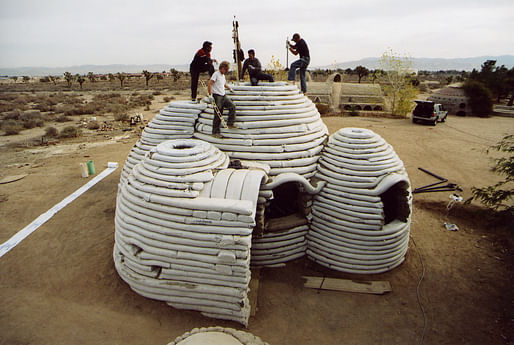
What is the architectural legacy of May 1968? The question framed Süha Özkan’s talk last Tuesday at SCI-Arc, which he began by invoking his own memories of being a young man in Paris during that year's turbulent month of student-worker protests. “Let us be reasonable and ask for the impossible,” Özkan said, quoting the famous slogan that was “uttered in the streets of Paris while stones were thrown.”
For Özkan, the demonstrations of ’68 introduced a new set of values into “the architectural agenda.” He described the preceding parts of the twentieth century as defined by “polarities and oppositions”: west vs east; capitalism vs communism; developed vs underdeveloped; blue vs red; north vs south; conservative vs progressive; right vs left. With ’68, a set of new values were introduced, disrupting this binary structure. According to Özkan, these new values included participation, plurality, freedom, non-discrimination and peace. Today, during the beginning decades of the 21st century, Özkan believes more concerns can be added to this list, in particular those surrounding issues of ecology, conservation, sustainability, partnerships and sharing.

Tracing a brief history from Vitruvius up to the work of Frank Gehry, Zaha Hadid, and (his host) Eric Owen Moss, Özkan asserted the changing relationship between architectural dictums and practice. Architecture, he contended, has never had a singular authoritative theory. Rather, innovation has emerged from the introduction and establishment of new certainties. Regarding the more recent practices – some of whom have notably been lumped together as a sort of post-’68 generation – Özkan acknowledged their formal innovations but tended to focus more on an expanded notion of their buildings’ impacts. For example, he discussed Gehry’s Guggenheim Bilbao primarily in terms of its role as the progenitor of the “Bilbao Effect,” or the insertion of a noted work of architecture into a generally-depressed area in the hopes for economic revival. Similarly, he considered the relation of Moss’ work to the transformative revitalization of the Culver City neighborhood of Los Angeles.

The bulk of Özkan’s talk was oriented around lesser-known practices from around the world. As he passed through a litany of examples, he touched on the ways in which each seemed to introduce a new imperative into architectural thinking. While many of his examples were from the last century, each seemed to fit within the parameters of “the architectural agenda” of the twenty-first century that he had previously laid out – namely, they involved a persistent concern with ecological and social issues. He discussed the National Commercial Bank in Jedda, Saudi Arabia – the last project completed by Gordon Bunshaft – in terms of its novel implementation facilitations of passive air-circulation and cooling (floorplans pictured above). Likewise, he considered a few of the bioclimatic skyscrapers of Ken Yeang. Özkan moved on to various landscape architecture projects, notably in the Middle East, and the ways in which they succeeded through a simultaneous defiance of traditional thinking accompanied by the introduction of something like a new dictum or postulate. For example, looking at Frei Otto’s Tuwaiq Palace, Özkan pointed to the clear circumscribing of the site as an innovation that proved fundamental to the project’s operability within its landscape. Discussing the work of Bödeker Partners in Riyadh, Özkan revealed how they were able to – almost paradoxically – green a desert using boulders.

Özkan continued on his list, shifting more towards explicitly socially-concerned practices. He discussed both Himanshu Parikh’s Slum Networking project in Indore City and the microfinance organization Grameen Bank, in light of the ways in which they gave agency back to their clients rather than imposing form. Özkan praised the recycling efforts of “Pedals for Progress,” a group that collects old bicycles from the “developed world,” rehabilitates them, and distributes them to the “underdeveloped world.” He considered the legacy of Hassan Fathy, looking at various practices that invest in locally-sourced materials and traditional building design, such as Architecture Sans Bois and Cal-Earth. Özkan moved on to discuss projects by Jean Nouvel and Norman Foster before considering a set of innovative conservation practices. Of particular interest was the work of Mohammed Benaissa, the former foreign minister of Morocco, who was able to create a steady income-flow for the preservation Asilah, Morocco by establishing an annual arts festival.

Over the hour and a half talk, Özkan covered a diverse array of architectural practices and works. While he may not have dedicated to each project the time it deserved, his efforts are commendable. Tracing a sort of dialectic yet nonlinear progression, Özkan looked at each of his case studies to find a seeming impossibility rendered possible. Implicit in his talk was an injunction to conceive of architecture in an expanded sense: as a set of relations organized around place. In a time in which the concept of architectural innovation seems increasingly tethered to technologies, Özkan convincingly explicated the radicalism of socially-aware architecture, even when it appears traditional.
No Comments
Süha Bey is either guilty by association or an optimist who knows many architectures. I prefer the latter like the most people. When I asked him about the ZHA's Kartal project a while back, I also saw the former in him. I think he is more of an architectural ambassador. Nice selection of a cover photo with Medusa in the cistern.
Block this user
Are you sure you want to block this user and hide all related comments throughout the site?
Archinect
This is your first comment on Archinect. Your comment will be visible once approved.